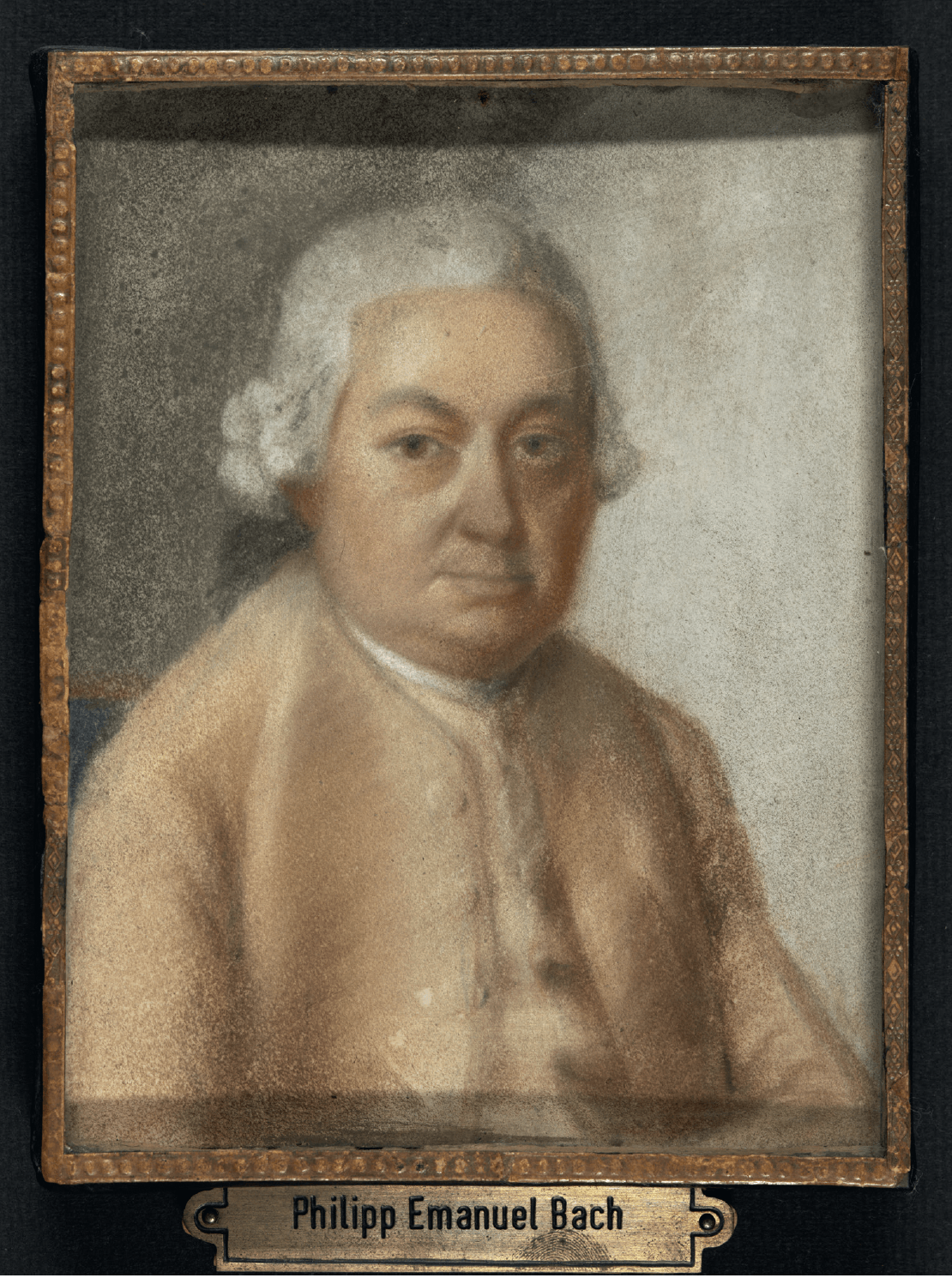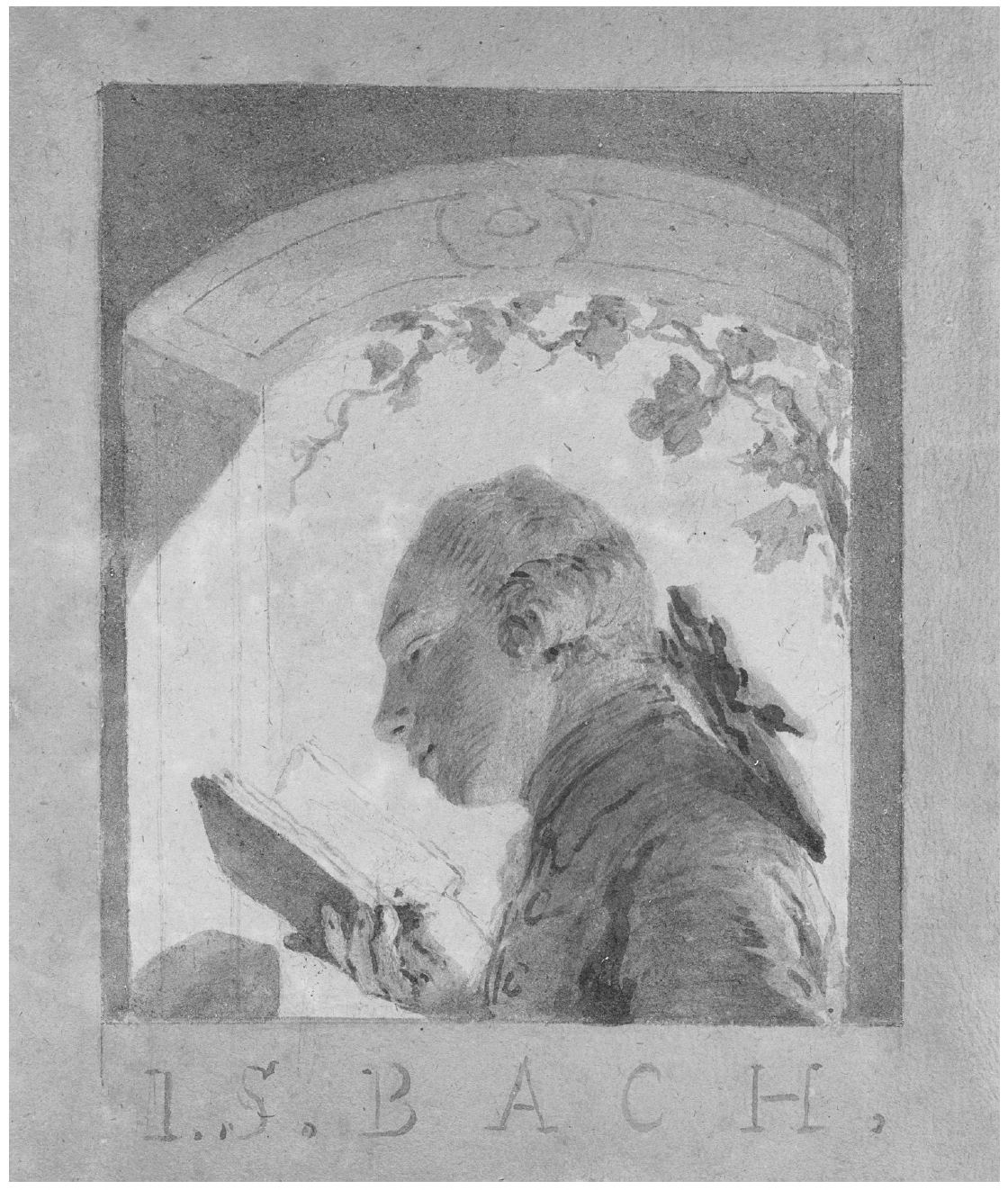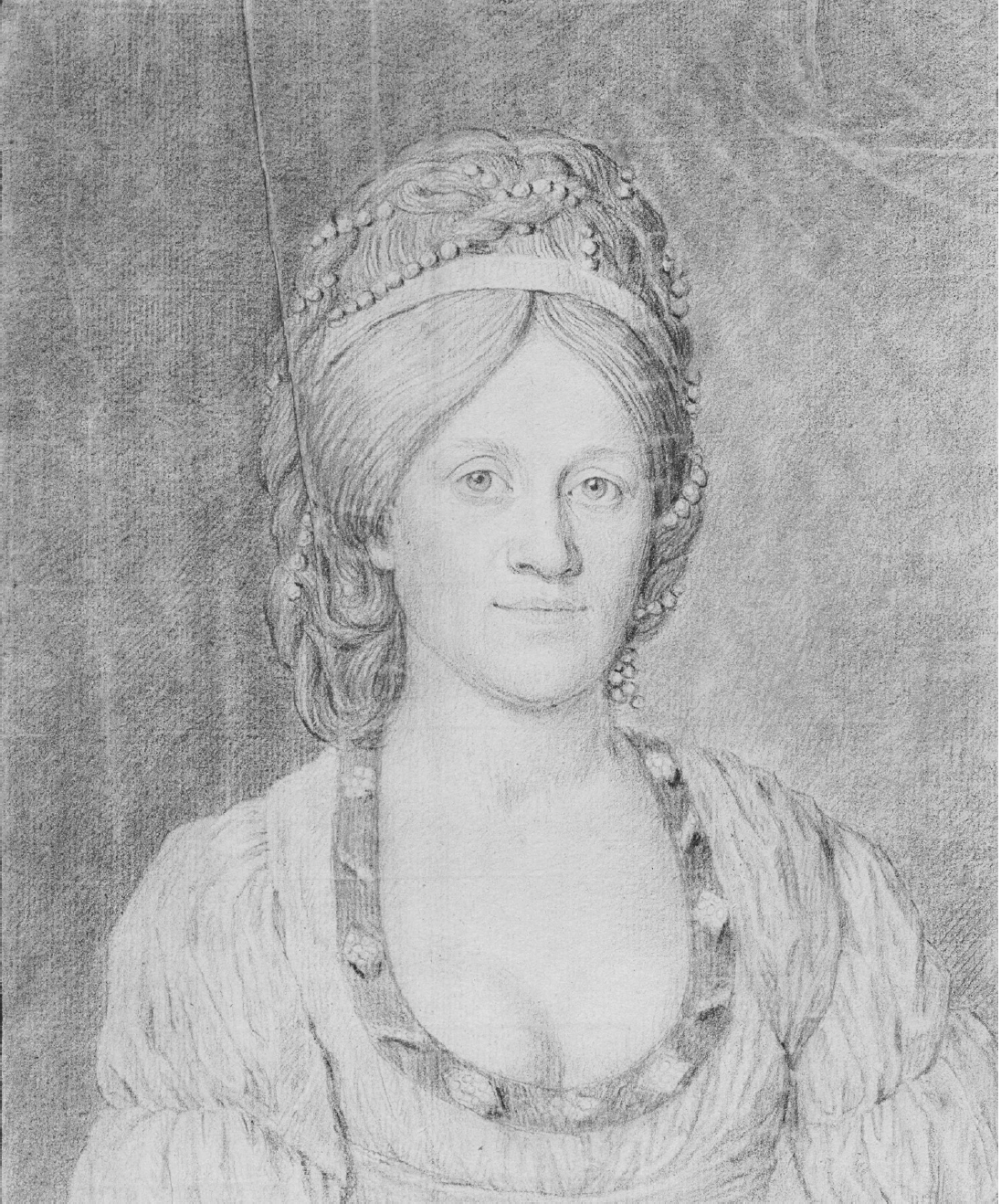Unearthed musical manuscripts of previously unknown works by great composers make headlines. But discoveries that don’t involve sheets of music can be even more revealing for the texture and depth they give to musicians’ lives and works. Music is never the notes alone.
As countless record covers confirm, musicians’ faces are crucial to eliciting feeling, conjuring a sense of connection with the performer or composer, with the sounds we hear on LP, in the concert hall, or in our heads. Annette Richards’ The Temple of Fame and Friendship: Portraits, Music, and History in the C. P. E. Bach Circle is a magisterial, yet intimate study of portraits of musicians that looks searchingly at faces for their crucial, if often elusive meanings. Her visual sensitivity is matched by her sharp hearing for the music associated with these faces and the social worlds they inhabited. Just as any picture can be viewed from different angles and in different light and will say different things to us at different times, this book presents diverse and thought-provoking perspectives on musicians’ portraits, constantly reminding us that music is an activity that brings people together in thought and deed and feeling.
Her magnificent, sumptuously-produced book paints an admiring, illuminating portrait of Carl Philip Emanuel Bach, the most famous member of his celebrated family in the 18th century, more renowned than his father, Johann Sebastian.
Emanuel was revered by thinkers and musicians of his day, from Diderot to Haydn to Mozart. The eminent Hamburg poet Friedrich Gottlieb Klopstock wrote his friend’s epitaph in 1788:
Tarry not imitators,
For you must blush if you remain.
Carl Philipp Emanuel Bach,
Profoundest harmonist,
United novelty and beauty;
Was great
In text-led strains
But greater yet
In bold, wordless music;
Surpassed the inventor of keyed instruments,
For he raised the art of performance
Through teaching
And practice
To its perfection.
Unlike his many brothers and their father, C. P. E. Bach was artistically celebrated and financially successful. Some of the proceeds from his profitable publications for the burgeoning market for keyboard music went to feed his collecting habit: even up to the last months of his life he continued to fill out his holdings of portraits; these were mostly engravings (rather than one-off images), but included drawings, oil paintings, plaster busts and silhouettes. The figures ranged from musical gods—Pan, Apollo and Mercury, to musical polymaths Johannes Kepler and Benjamin Franklin, to musicians, both famous and obscure, ranging from Bach’s time back two hundred years and including men and women mostly from Germany but also from across Europe.
Richards describes the intense discussion and widespread emulation of Bach’s collection. His holdings buttressed his own fame but were also a vital mode of staying connected with the musicians of his day. There was nothing Meta about this social network: Bach’s faces were to be seen, held, and heard.
The musical man-of-letters, the Englishman Charles Burney visited Bach in 1772, and in his travel diary described the thrill of hearing the great man play surrounded by the images of so many musicians, including the stern visage of J. S. Bach himself:
The instant I entered [his house], M. Bach conducted me up stairs, into a large and elegant music room, furnished with pictures, drawings, and prints of more than a hundred and fifty eminent musicians: among whom, there are many Englishmen, and original portraits, in oil, of his father and grandfather. After I had looked at these, M. Bach was so obliging as to sit down to his Silbermann clavichord, and favourite instrument, upon which he played three or four of his choicest and most difficult compositions, with the delicacy, precision, and spirit, for which he is so justly celebrated among his countrymen.

C. P. E. Bach. Pastel by Johann Philipp Bach, c 1777.
Burney had embarked on his European travels in order to conduct research for his General History of Music, the first volume of which appeared a few years after the Hamburg visit. Portraits, especially those assembled by C. P. E. Bach, played an important role in the conception of music history found in the first comprehensive works dedicated to the subject by Burney and his German counterparts. Coming from the most venerable of musical families, Bach nurtured a profound sense of history and his own place in it.
As Richards shows, the anecdotes that characterized these histories can be thought of not only as annotations of a picture gallery, but as an attempt to flesh out the faces with musical temperament and bring the past to sounding life—long before the age of recorded sound.
Because of C. P. E. Bach’s musical prestige and the fame of his collection, his portraits were coveted by enthusiasts and admirers. Bach had hoped that the collection would stay intact after his death—a dream of many a collector. In the end it was dispersed, much of it snapped up by those with close connections to the composer and his family. Bach made a catalogue not only of his musical compositions, but also of his portrait collection; this careful inventory shows how important both oeuvres were to the artist.
C. P. E. Bach’s love of art, and especially portraiture, must also have contributed to the career path of his second son, named after his illustrious grandfather. Johann Sebastian Bach the Younger was a promising artist, who often helped his own father’s collecting interests through his connections in the art world and his own talent for capturing likenesses. Unforgettable is the grief-stricken letter in which C. P. E. Bach laments his son’s death at the age of 29 while studying art in Rome.

Drawing of J. S. Bach the Younger by Adamd Friedrich Oese, 1778.
Already two decades ago, Richards suspected that many of these portraits had made their way into the State Library in Berlin, as had so much of the Bach family’s music. With C. P. E. Bach’s careful descriptions in hand, she went through countless drawers of hand-written cards in the massive musical portrait holdings of the library, and ultimately found nearly a third of Bach’s personal pictures. Most of these were prints, some with Bach’s wavering handwriting giving the subject, artist, and inventory number. More dramatic were Richards’s discovery of original drawings, some by important north German and Italian artists.
On a spring morning in 2004 I busied myself with some old musical manuscripts in the Berlin State Library in uxorious proximity to Richards (these coy multi-syllabics probably don’t quite count as full disclosure so here it is: I’m married to the author of The Temple of Fame and Friendship). Annette was waiting for the first trolley of portraits she’d been able to order up after nearly a year of patient and polite  inquiring.
inquiring.
In those days the library’s Music Reading Room was still tattily resplendent in its full East German glory: blond plywood, brown carpets, Sputnik lamps. This cocoon of socialist socialist chic inside the hulking war-scarred Prussian edifice finished in the fateful year of 1914.
To our left at the long table, an American musicologist examined a manuscript with a magnifying glass. To our right a beleaguered German Ph.D. student stared at a stack of treatises. Across the table, just arrived in the library well after opening time, a gray-haired American professor jostled elbows with his fetching young assistant, both seemingly more intent on deciphering each other than the Beethoven sketchbook in front of them. At the far end of the table a Japanese scholar put on his white gloves.
The trolley arrived for Annette and she took the first image carefully out of its folder. One could feel all the eyes in the room look up from their work and at the face of Madame Benda, one of the great singers of the age, shining in the morning light pouring through the tall windows.

Maria Felicitas Benda (1756 to after 1788). Drawing by Johann Andreas Herterich, 1781.
One of the most welcome outcomes of Richards’s project conducted over many years is that these drawings rescued from the acid-rich folders they had long been stored in have now been preserved according to modern archival standards.
Richards made discoveries in other libraries, too, and using Bach’s pictures as well as exemplars of his prints from other archives, she reconstructed his collection. Over the next several years she prepared a catalogue of the collection with reproductions of the images for the edition of C. P. E. Bach’s complete works. In 2010 she curated an exhibition of the portraits at the Bach-Archiv in Leipzig—the first chance ever for the public to see them.
In the just-published book that is the culmination of all these efforts, Richards makes many fascinating links between those portrayed and Bach himself; his contemporaries were proud to be part of Bach’s collection, as if enshrined in an 18th-century musical hall of fame.
Not only the prominent and history-making, but also now-forgotten players on the European stage, fired Bach’s collecting imagination. These curiosities seem to say as much about the past as do the great figures such as Haydn, Gluck, Rosseau and Benjamin Franklin (inventor of the glass harmonica). The book includes a rare print of the Polish cello prodigy Nicolaus Zygmuntowski, who played across Europe at major venues such as the Concert spirituel in Paris. Richards tells us that the Bach-follower Ernst Ludwig Gerber, whose important biographical dictionary of musicians of 1790 includes a long appendix devoted to portraits, reports that Zygmuntowski “died at the age of eleven, having been overworked, beaten and starved by his father.” Prodigies are often older than their handlers claim, though this is a brutal précis of the rampant exploitation of musically-gifted children that marred the 18th century. Zygmuntowski died a few years before Bach himself did. One suspects that Bach knew of the young Pole’s fate. Perhaps he was even the one who reported it to Gerber. These portraits were not just about capturing the drama of the human face, but also about the stories behind them, to be seen, in the case of Zygmuntowki in his stoic, slightly stunned expression.

Nicolaus Zygmuntowski (c. 17771-1782/86). Engraving by Carl Salzer (1740-1784).
When Bach sat at his clavichord and played for himself or in company, he must also have enjoyed being watched over by his father and so many other musicians, both living and dead. Perhaps he liked to think that they were listening, too. I don’t doubt that the music he made drew power not only from their compositions and the memory of their performances, but from the presence of their faces on his walls. Return to this world of feeling and music, sight and sound, in The Temple of Fame & Friendship.